At the time of the creation of this article, North Texas is enduring a severe drought. The last time a similar drought was experienced in North Texas was 2011, just over a decade ago. Long periods of extreme heat combined with very low rainfall can result in extreme drought stress conditions. Without proper watering, these conditions can impact your lawn and landscape, eventually killing grass, many landscape plants and even trees. In this article, we will define drought stress, show examples of what both limited and severe drought stress look like as well as methods to combat it. We will also discuss lawn issues that can be mistaken as drought stress.
What is Drought Stress?
Drought stress occurs when the turfgrass’s requirement for water cannot be met by rainfall or supplemental irrigation. This will cause the turfgrass to go into premature dormancy. The turfgrass will direct its energy to protecting the root system, thus eliminating its efforts to produce new top growth. Certain varieties of turfgrasses have a better ability to withstand drought stress conditions for an extended amount of time. However, a prolonged period of drought stress will lead to the decline, and eventual death, of the turfgrass. The ability for turfgrass recovery is further decreased when their is an increased heat-index and lack of rainfall.
What Does Drought Stress Look Like?
Drought stress can present as both an isolated or widespread problem on your lawn. It can appear as minor as small patches of discolored turfgrass to the appearance of drastic voids in the soil. As shown in these North Texas lawn pictures below.
Limited Drought Stress on a Lawn
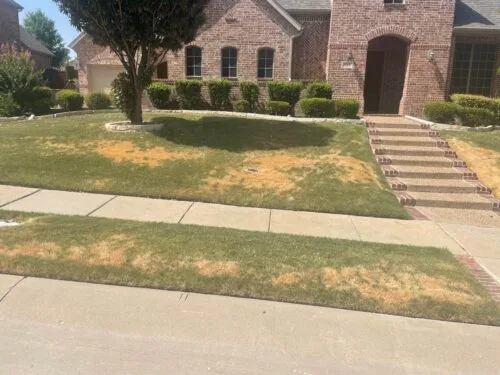
Widespread Drought Stress on a Lawn
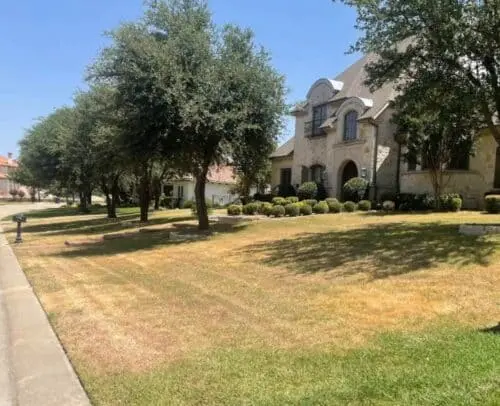
Our soil in North Texas contains a lot of clay. The soil tends to shrink or expand based on the amount of moisture present. Not only will improper watering affect your lawn, but it can also affect your home’s foundation. The soil will shrink and withdraw from your foundation without sufficient water. Over time, the foundation can settle into this empty space, causing cracks to form. Core aerating your lawn in the spring aeration will help your soil absorb more water, air and nutrients. Aeration also encourages deeper root growth. All of these benefits of aeration will help your turfgrass be healthier throughout the year.
Example of Severe Soil Shrinkage (ground cracking)
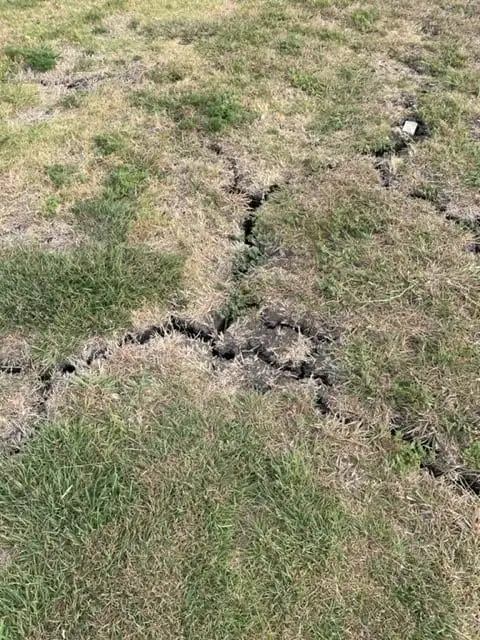
Soil Shrinking Away from the Foundation of a Home
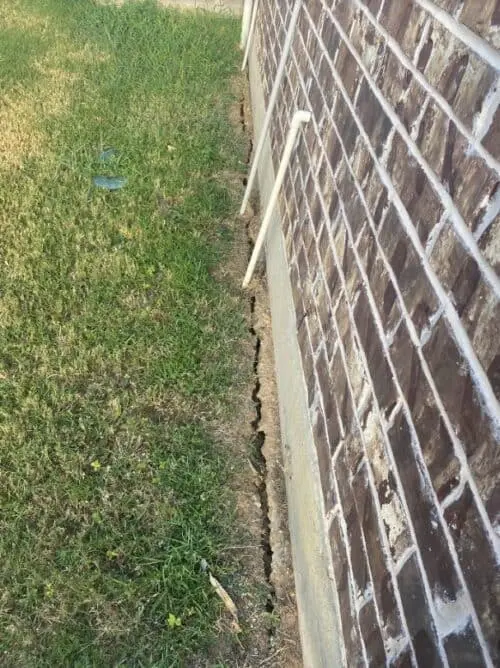
Radiating Heat
Heat radiating off a concrete curb can cause areas of the lawn to endure more heat, for longer periods of time, leading to drought stress. Sunlight reflecting off a brick walI onto the lawn can also create additional heat and lead to drought stress. In measurements taken the grass impacted by the radiant heat was as much as fifteen degrees hotter than unaffected grass in the lawn.
Radiating Heat from the Street and Curb Causing Drought Stress on Lawn
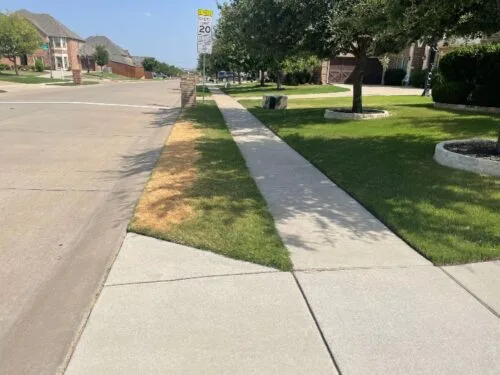
Radiating Heat off of a Brick Wall
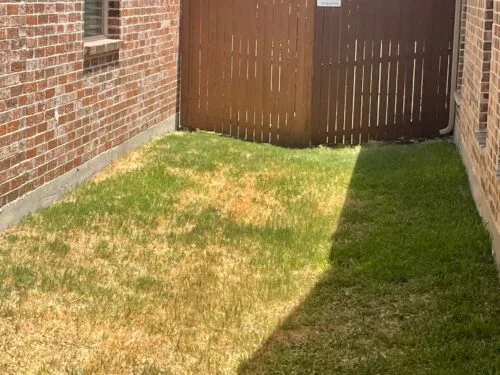
Drought Stress – Wind
Strong winds can blow water from sprinklers off-target and cause the soil to dry out faster. This yard does not have any windbreaks created by trees, neighboring houses, or even from a wooden fence on the east and south sides of the yard where prevailing winds come from during the summer months. This would be an area that would require increased watering during periods of drought.
What Are Lawn Issues That Can Look Like Drought Stress?
When there is extreme heat and drought conditions in the summer months, the case of brown patches on your lawn will most likely be caused by drought stress. However, what may appear to a homeowner as drought stress could also be damage caused by a disease, insects or even a lawn mower. Sometimes the assistance of a professional lawn care service like Weedex Lawn Care is necessary to get the proper diagnosis and treatments needed to get your lawn healthy again.
Lawn Fungus
Lawn fungus will turn your lawn from green to brown and sometimes yellow. Grey Leaf Spot is a common lawn disease that begins with yellowish chlorosis that ultimately turns brown, resembling the effects of drought stress. Grey Leaf Spot can be distinguished though through the numerous oblong greys to ash brown lesions that appear on the grass blades. Weedex Lawn Care offer a lawn fungus disease treatment program for St Augustine lawns.
Grey Leaf Spot Fungus in Lawn
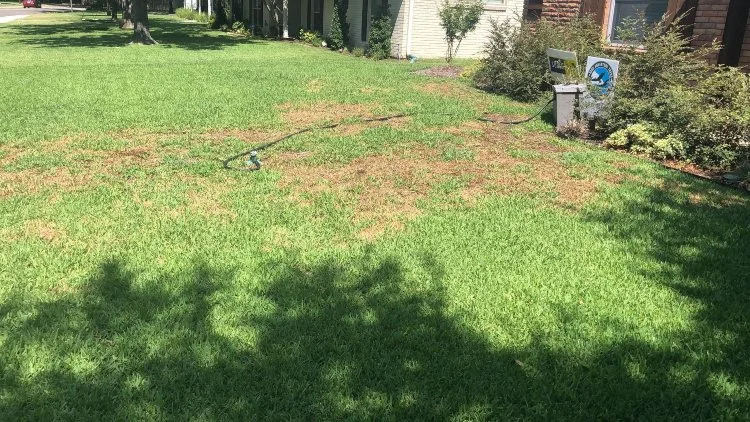
Close Up View of Grey Leaf Spot
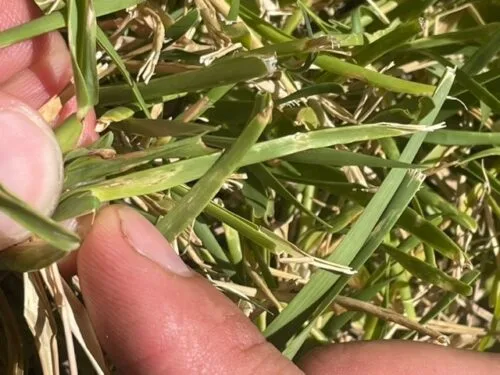
Lawn Insects
Lawn insects thrive in hot temperatures and their damage can sometimes be misinterpreted as drought stress. Two common lawn pests in North Texas are Bermuda mites and Chinch bugs. Bermuda mites are not visible with the naked eye, but their damage presents through shortened leaf blade growth causing the grass to look like a witch’s broom. Chinch bugs, on the other hand, are small but they can be visually identified with a trained eye by exposing the thatch layer of St. Augustine grass. When left untreated, chinch bugs damage creates patches of yellowish, brown turf that spreads outward.
Witches Broom (circled in red) in Lawn Damage Caused by Bermuda Mites
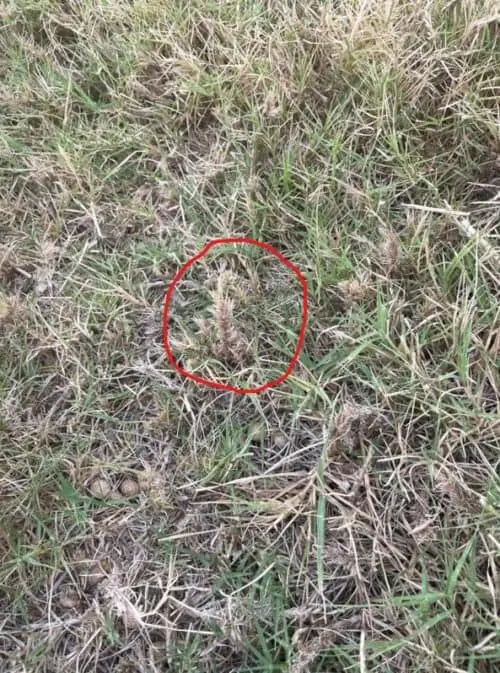
Close-up of Witches Broom Lawn Damage
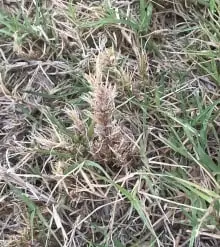
Chinch Bug Damage
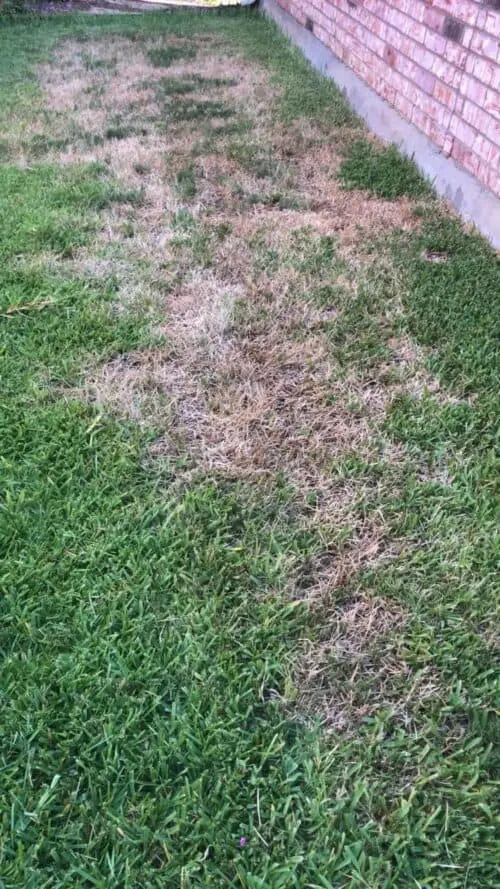
Chinch Bugs
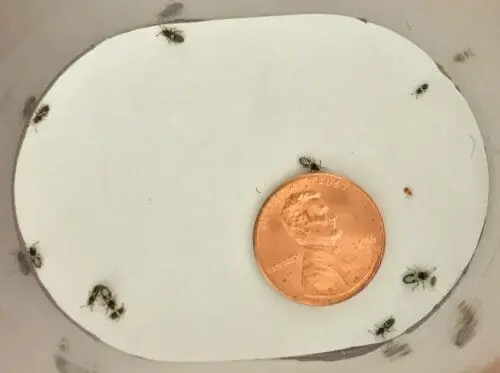
Improper Mowing Practices
Simple human error can also present itself as drought stress. It is important to make sure that you are always mowing your lawn at the proper height. Removing more than 1/3 of the leaf-blade in a single mow can result in removing most, if not all, of the green upper leaf blade of Bermudagrass or Zoysia turfgrass. This will make the lawn appear drought-stressed. This appearance can be easily fixed by adjusting both the mowing frequency and the height of your mower deck. The green portion of the leaf blades is also where photosynthesis and other processes occurs which are vital to the health of your lawn. Removing more than the top third of the grass blades will affect both the health and the beauty of your lawn.
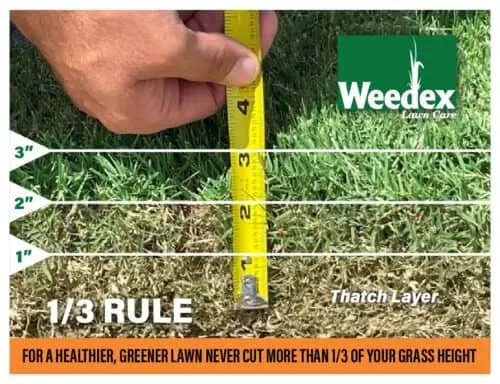
Example of a Lawn Cut Too Low
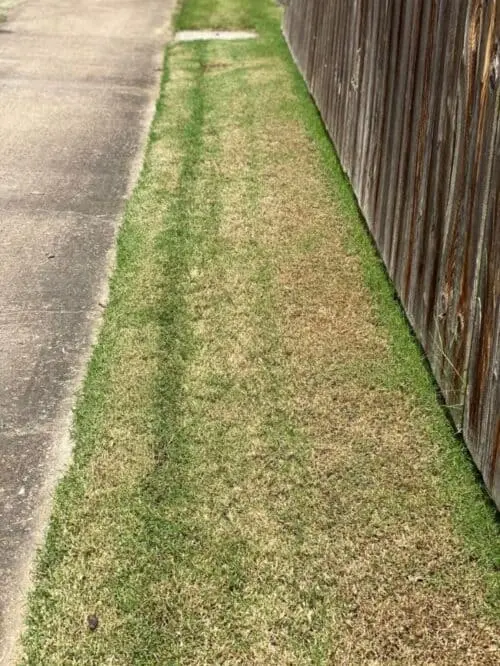
How Can I Combat Drought Stress?
One way to combat and avoid drought stress is ensuring you are properly watering your lawn. The time of Day, duration, and frequency are all critical factors when determining your watering schedule. Check out our article and YouTube video on testing for proper lawn irrigation coverage.
Most North Texas residents have had at least one experience with being placed on watering restrictions from their local municipality. This can occur when we have extended periods of no rainfall and excessive temperatures. Watering restrictions typically regulate the time of day and number of days each week you are allowed to run your sprinkler system. Your turf grass requires 1 to 1.5 inches of water per week to stay healthy. We recommend running each zone of pop-up spray heads for a total of one hour and rotor, also known as oscillating, heads for a total of two hours each week.
Pop up spray heads should run for 15 minutes per zone, while rotor (oscillating) heads should run for 30 minutes per zone and drip irrigation should run for 45 minutes per zone.
These run times will vary due to shade and slope issues on the lawn.
Weedex Recommend Lawn Watering Schedule

Even while under watering restrictions, following these recommendations will help you achieve the correct amount of water on your lawn. These guidelines will also minimize your amount of runoff. They are also appropriate for use both during and outside of watering restrictions.
It is important to ensure you are always achieving proper irrigation coverage. Check your irrigation system each spring to make sure all the components are working properly. This way, your system will be ready to irrigate effectively during hot summer weather. During periods with excessive risk of drought stress, it is also important to remain vigilant of your irrigation system through continual monitoring of zones and components.
Weedex Soil Builder Program
Our Soil Builder program is an additional effective method of combatting drought stress by providing your lawn with the nutrients it needs to recover. Each Soil Builder Application consists of four products; Firm Up, Receptor, Axilo Mix 5 and Renova. When combined, these products provide can improve the quality of your soil by increasing water movement and retention. They also work to extend the nutritional value of fertilization, and combat negative stressors to the lawn.
Firm Up allows water to better penetrate the soil profile and enhance soil wetting characteristics. This results in a more consistent level of moisture for the turfgrass to help minimize drought stress conditions. Firm Up will help the turfgrass perform at its best.
Receptor helps increase the soil ability to recycle nutrients. Increased root development is key to any plants survival and these hormones help increase the overall turfgrass root mass, improving its ability to better absorb more moisture and nutrients.
Axilo Mix 5 is a slow-release nutrient package that allows the plant to absorb nutrients more readily as it needs it. Within those nutrients is magnesium, a necessary component of chlorophyll – what makes the plant green – thus allowing the turfgrass to replenish chlorophyll levels at its maximum capacity and restore its deep-green color.
Renova is an extract of multiple plants species that contain different hormones intended to fight environmental stressors, such as drought stress. Like a daily vitamin, this helps prepare the plant for whatever expected or unexpected situations it must live through.
Remember that a healthy lawn will better tolerate drought stress. Regular application of fertilization, proper watering and mowing are all needed. To ensure a healthy lawn and a proper lawn diagnosis, hire a local lawn care professional. They will partner with you on the care of your lawn. Weedex Lawn Care has been serving North Texas homeowners with award-winning service for over 20 years!
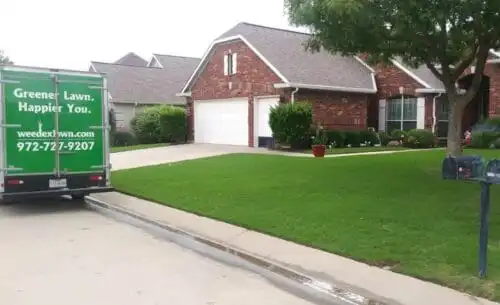
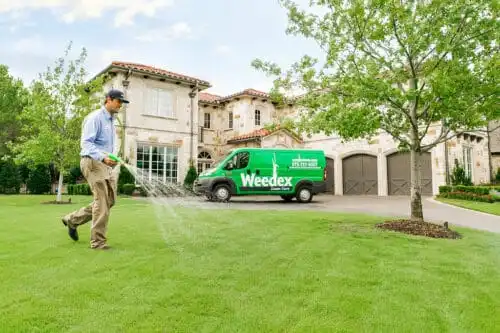
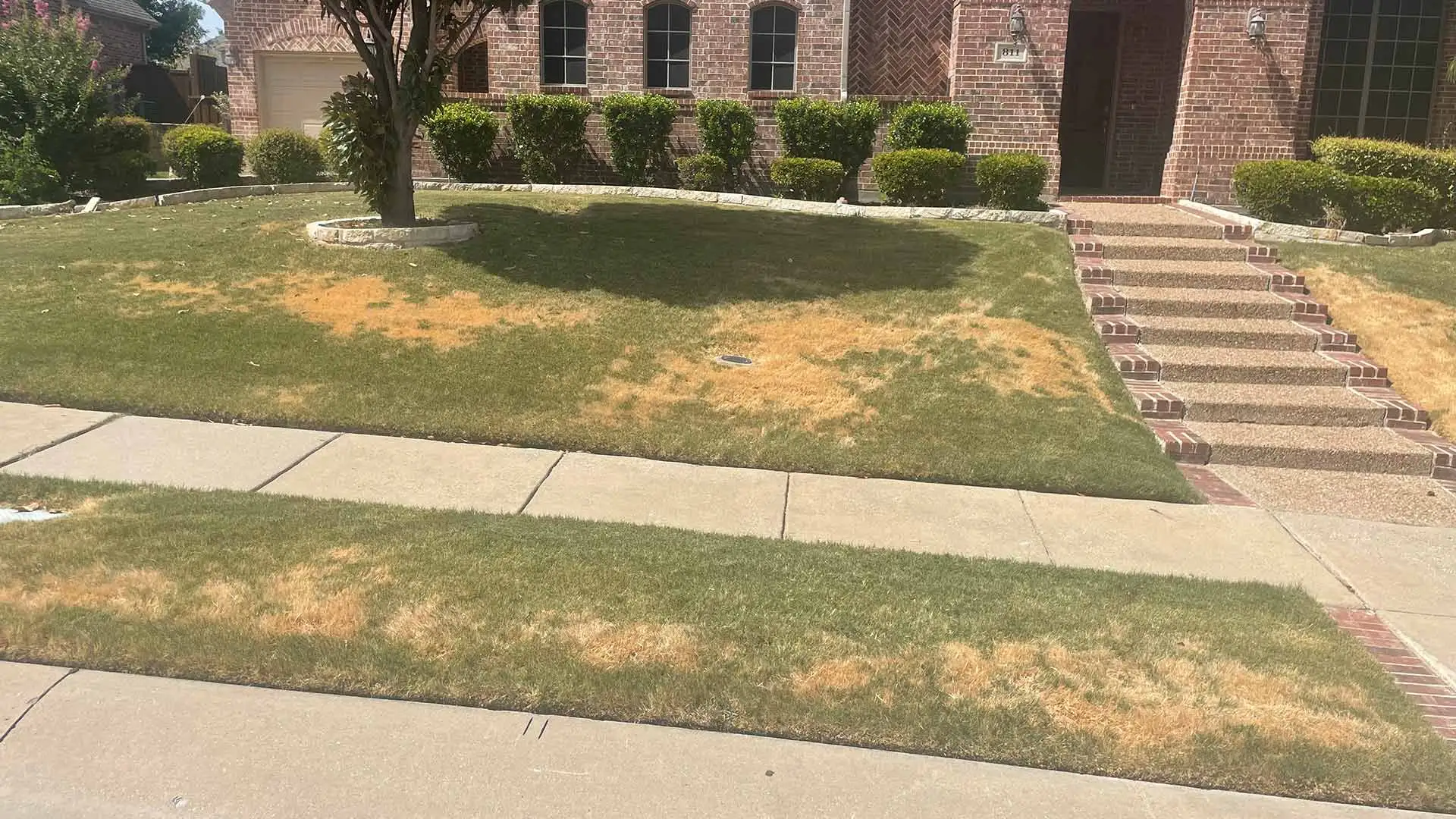

Comments (0)
Thanks for your comment!
Thanks for your feedback! Your comments have been successfully submitted! Please note, all comments require admin approval prior to display.
Error submitting comment!
There is a problem with your comment, please see below and try again.